Simulating 10,000 Years of Erosion to Assess Nuclear Waste Repository Performance
Abstract
1. Introduction
2. Materials and Methods
2.1. Modeling Background
2.1.1. Governing Equations
- Qs = sediment flux through a grid cell (kg/m width)
- B = a coefficient that establishes the rate of sediment transport
- A = area that contributes to runoff (m2)
- S = terrain slope (m/m)
- m, n = exponents used to define how sediment yield depends on runoff contribution
- area (A) and slope (S) for a given cell
- Dz = diffusion coefficient (kg/m width)
2.1.2. Model Assumptions
2.2. Methods
2.2.1. Model Parameterization and Validation
2.2.2. Initial Domain Landform
2.2.3. Model Simulations
3. Results
3.1. 10,000-Year Erosion Analysis
3.2. Impact of Riprap Armor
3.3. Canyon Deposition
4. Discussion
4.1. 10,000-Year Forecast Uncertainty
4.2. Geomorphically Effective Runoff Event Assumption
4.3. Steps to Improve the Long-Term Erosion Assessment
5. Conclusions
Author Contributions
Funding
Acknowledgments
Conflicts of Interest
References
- U.S. Department of Energy. Department of Energy (DOE) Radioactive Waste Management, U.S. Department of Energy Order 435.1, (change 1 to document issued July 9, 1999). Available online: https://www.directives.doe.gov/directives-documents/400-series/0435.1-BOrder/@@images/file (accessed on 28 August 2001).
- Macfarlane, A.; Ewing, R.C. (Eds.) Uncertainty Underground: Yucca Mountain and the Nation’s High-Level Nuclear Waste; MIT Press: Cambridge, MA, USA, 2006. [Google Scholar]
- Slovic, P.; Flynn, J.H.; Layman, M. Perceived risk, trust, and the politics of nuclear waste. Science 1991, 254, 1603–1607. [Google Scholar] [CrossRef] [PubMed]
- Willgoose, G.; Riley, S. The Long Term Stability of Engineered Landforms of the Ranger Uranium Mine, Northern Territory, Australia: Application of a Catchment Evolution Model. Earth Surf. Process. Landf. 1998, 23, 237–259. [Google Scholar] [CrossRef]
- Willgoose, G.R.; Bras, R.L.; Rodriguez-Iturbe, I. A coupled channel network growth and hillslope evolution model, I. Theory. Water Resour. Res. 1991, 27, 1671–1684. [Google Scholar] [CrossRef]
- Willgoose, G. Mathematical modeling of whole landscape evolution. Annu. Rev. Earth Planet. Sci. 2005, 33, 443–459. [Google Scholar] [CrossRef]
- Laflen, J.; Lane, L.; Foster, G. WEPP—A New Generation of Erosion Prediction Technology. J. Soil Water Conserv. 1991, 46, 34–38. [Google Scholar]
- Smith, R.; Goodrich, D.; Woolhiser, D.; Unkrich, C. Chapter 20: KINEROS—A Kinematic Runoff and Erosion Model. In Computer Models of Watershed Hydrology; Singh, V., Ed.; Water Resources Publications: Highlands Ranch, CO, USA, 1995; pp. 697–732. [Google Scholar]
- Lane, L.; Nichols, M.; Levick, L.; Kidwell, M. A Simulation Model for Erosion and Sediment Yield at the Hillslope Scale. In Landscape Erosion and Evolution Modeling; Harmon, R., Doe, W., III, Eds.; Kluwer Academic: New York, NY, USA; Plenum Publishers: New York, NY, USA, 2001; Chapter 8; pp. 201–237. [Google Scholar]
- Coulthard, T.J. Landscape evolution models: A software review. Hydrol. Process. 2001, 15, 165–173. [Google Scholar] [CrossRef]
- Chen, A.; Darbon, J.; Morel, J.M. Landscape evolution models: A review of their fundamental equations. Geomorphology 2014, 219, 68–86. [Google Scholar] [CrossRef]
- Hancock, G.R.; Lowry, J.B.C.; Coulthard, T.J. Catchment reconstruction—Erosional stability at millennial time scales using landscape evolution models. Geomorphology 2015, 231, 15–27. [Google Scholar] [CrossRef]
- Baartman, J.E.; Temme, A.J.; Veldkamp, T.; Jetten, V.G.; Schoorl, J.M. Exploring the role of rainfall variability and extreme events in long-term landscape development. Catena 2013, 109, 25–38. [Google Scholar] [CrossRef]
- Hancock, G.R.; Evans, K.G.; Willgoose, G.R.; Moliere, D.R.; Saynor, M.J.; Loch, R.J. Medium-term erosion simulation of an abandoned mine site using the SIBERIA landscape evolution model. Soil Res. 2000, 38, 249–264. [Google Scholar] [CrossRef]
- Evans, K.G.; Saynor, M.J.; Willgoose, G.R.; Riley, S.J. Post-mining landform evolution modelling: 1. Derivation of sediment transport model and rainfall–runoff model parameters. Earth Surf. Process. Landf. J. Br. Geomorphol. Res. Group 2000, 25, 743–763. [Google Scholar] [CrossRef]
- Moliere, D.R.; Evans, K.G.; Willgoose, G.R. Temporal Trends in Erosion and Hydrology for a Post-Mining Landform at Ranger Mine; Environmental Research Institute of the Supervising Scientist: Darwin, Australia, 2002; p. 31.
- Evans, K.G.; Willgoose, G.R. Post-mining landform evolution modelling: 2. Effects of vegetation and surface ripping. Earth Surf. Process. Landf. J. Br. Geomorphol. Res. Group 2000, 25, 803–823. [Google Scholar] [CrossRef]
- Wilson, C.J.; Crowell, K.J.; Lane, L.J. Surface Erosion Modeling for the Repository Waste Cover at Los Alamos National Laboratory Technical Area 54, Material Disposal Area G; Los Alamos National Laboratory Report LA-UR-05-7771; Los Alamos National Laboratory: Los Alamos, NM, USA, 2005.
- French, S.; Crowell, K.J. Updated Surface Erosion Modeling for Repository Waste Cover at Los Alamos National Laboratory Technical Area 54, Area G; Los Alamos National Laboratory Report LA-UR-10-06442; Los Alamos National Laboratory: Los Alamos, NM, USA, 2010.
- Stauffer, P.H.; Chu, S.; Miller, T.A.; Strobridge, D.; Cole, G.; Birdsell, K.H.; Robinson, B.A.; Gable, C.W.; Broxton, D.E.; Springer, E.P.; et al. Groundwater Pathway Model for the Los Alamos National Laboratory, Technical Area 54, Area G; Revision 1, LA-UR-13-24014; Los Alamos National Laboratory: Los Alamos, NM, USA, 2013.
- Hancock, G.R.; Coulthard, T.J.; Lowry, J.B.C. Predicting uncertainty in sediment transport and landscape evolution–the influence of initial surface conditions. Comput. Geosci. 2016, 90, 117–130. [Google Scholar] [CrossRef]
- Hancock, G.R.; Lowry, J.B.C.; Saynor, M. Surface Armour and Erosion–Impacts on Long-term Landscape Evolution. Land Degrad. Dev. 2017, 28, 2121–2136. [Google Scholar] [CrossRef]
- Crowell, K.J. Sensitivity of Surface Erosion Modeling for Los Alamos National Laboratory Technical Area 54, Area G; Los Alamos National Laboratory Report LA-UR-13-24013; Los Alamos National Laboratory: Los Alamos, NM, USA, 2013.
- Willgoose, G.R. A Physically Based Channel Network and Catchment Evolution Model. Ph.D. Thesis, Massachusetts Institute of Technology, Cambridge, MA, USA, 1989. [Google Scholar]
- Willgoose, G.R.; Bras, R.L.; Rodriguez-Iturbe, I. A physical explanation of an observed link area-slope relationship. Water Resour. Res. 1991, 27, 1697–1702. [Google Scholar] [CrossRef]
- Tucker, G.E.; Hancock, G.R. Modelling landscape evolution. Earth Surf. Process. Landf. 2010, 35, 28–50. [Google Scholar] [CrossRef]
- Stone, J.J.; Lane, L.J.; Shirley, E.D. Infiltration and Runoff Simulation on a Plane. Trans. Am. Soc. Agric. Eng. 1992, 35, 161–170. [Google Scholar] [CrossRef]
- Dalrymple, T. Flood Frequency Analyses, Manual of Hydrology: Part 3. Flood-Flow Techniques; USGS Water Supply Paper 1543-A; U.S. Government Publishing Office: Washington, DC, USA, 1960; 86p.
- Sveinsson, O.G.; Boes, D.C.; Salas, J.D. Population index flood method for regional frequency analysis. Water Resour. Res. 2001, 37, 2733–2748. [Google Scholar] [CrossRef]
- Bonnin, G.M.; Martin, D.; Lin, B.; Parzybok, T.; Yekta, M.; Riley, D. NOAA Atlas 14: Precipitation-Frequency Atlas of the United States; Volume 1 Version 4.0: Semiarid Southwest (Arizona, Southeast California, Nevada, New Mexico, Utah); National Weather Service: Silver Spring, MD, USA, 2006; 261p.
- Lane, L.J. The Role of Large Storms in Determining Mean Annual Sediment Yield. Proc. Am. Soc. Min. Reclam. 2007, 403–412. [Google Scholar] [CrossRef]
- Springer, E.P. Statistical Exploration of Matrix Hydrologic Properties for the Bandelier Tuff, Los Alamos, New Mexico; Los Alamos National Laboratory Report LA-UR-04-2830; Los Alamos National Laboratory: Los Alamos, NM, USA, 2004.
- Day, M.S.; Anderson, C.K.; Pedersen, C.D. Conceptual Design of the Earthen Cover for at Los Alamos National Laboratory Technical Area 54, Material Disposal Area G; URS Corporation Report to LANL, Los Alamos National Laboratory Report LA-UR-05-7394; Los Alamos National Laboratory: Los Alamos, NM, USA, 2005.
- Los Alamos National Laboratory (LANL). Performance Assessment and Composite Analysis for Los Alamos National Laboratory Technical Area 54, Area G; Revision 4, Los Alamos National Laboratory Report LA-UR-08-6764; Los Alamos National Laboratory: Los Alamos, NM, USA, 2008.
- Tarboton, D.G. A new method for the determination of flow directions and upslope areas in grid digital elevation models. Water Resour. Res. 1997, 33, 309–319. [Google Scholar] [CrossRef]
- Coulthard, T.J.; Neal, J.C.; Bates, P.D.; Ramirez, J.; Almeida, G.A.; Hancock, G.R. Integrating the LISFLOOD-FP 2D hydrodynamic model with the CAESAR model: Implications for modelling landscape evolution. Earth Surf. Process. Landf. 2013, 38, 1897–1906. [Google Scholar] [CrossRef]
- Molnar, P.; Anderson, R.S.; Kier, G.; Rose, J. Relationships among probability distributions of stream discharges in floods, climate, bed load transport, and river incision. J. Geophys. Res. 2006, 111, F02001. [Google Scholar] [CrossRef]
- Lague, D.; Hovius, N.; Davy, P. Discharge, discharge variability, and the bedrock channel profile. J. Geophys. Res. 2005, 110. [Google Scholar] [CrossRef]
- Swetnam, T.W.; Betancourt, J.L. Mesoscale disturbance and ecological response to decadal climatic variability in the American Southwest. J. Clim. 1998, 11, 3128–3147. [Google Scholar] [CrossRef]
- Sheppard, P.R.; Comrie, A.C.; Packin, G.D.; Angersbach, K.; Hughes, M.K. The climate of the US Southwest. Clim. Res. 2002, 21, 219–238. [Google Scholar] [CrossRef]
- Moody, J.A.; Martin, D.A. Post-fire, rainfall intensity–peak discharge relations for three mountainous watersheds in the western USA. Hydrol. Process. 2001, 15, 2981–2993. [Google Scholar] [CrossRef]
- Moody, J.A.; Shakesby, R.A.; Robichaud, P.R.; Cannon, S.H.; Martin, D.A. Current research issues related to post-wildfire runoff and erosion processes. Earth-Sci. Rev. 2013, 122, 10–37. [Google Scholar] [CrossRef]
- Moody, J.A.; Ebel, B.A. Infiltration and runoff generation processes in fire-affected soils. Hydrol. Process. 2014, 28, 3432–3453. [Google Scholar] [CrossRef]
- Atchley, A.L.; Kinoshita, A.M.; Lopez, S.R.; Trader, L.; Middleton, R. Simulating surface and subsurface water balance changes due to burn severity. Vadose Zone J. 2018, 17. [Google Scholar] [CrossRef]
- Cannon, S.H. Debris-flow generation from recently burned watersheds. Environ. Eng. Geosci. 2001, 7, 321–341. [Google Scholar] [CrossRef]
- Cawson, J.; Sheridan, G.; Smith, H.; Lane, P. Effects of fire severity and burn patchiness on hillslope-scale surface runoff, erosion and hydrologic connectivity in a prescribed burn. For. Ecol. Manag. 2013, 310, 219–233. [Google Scholar] [CrossRef]
- Hyde, K.D.; Wilcox, A.C.; Jencso, K.; Woods, S. Effects of vegetation disturbance by fire on channel initiation thresholds. Geomorphology 2014, 214, 84–96. [Google Scholar] [CrossRef]
- Cannon, S.H.; Reneau, S.L. Conditions for generation of fire-related debris flows, Capulin Canyon, New Mexico. Earth Surf. Process. Landf. 2000, 25, 1103–1121. [Google Scholar] [CrossRef]
- Moody, J.A.; Martin, D.A.; Haire, S.L.; Kinner, D.A. Linking runoff response to burn severity after a wildfire. Hydrol. Process. 2008, 22, 2063–2074. [Google Scholar] [CrossRef]
- Maurer, T.; Gerke, H.H. Processes and modeling of initial soil and landscape development: A review. Vadose Zone J. 2016, 15. [Google Scholar] [CrossRef]
- Del Genio, A.D.; Yao, M.S.; Jonas, J. Will moist convection be stronger in a warmer climate? Geophys. Res. Lett. 2007, 34. [Google Scholar] [CrossRef]
- Trenberth, K.E.; Dai, A.; Rasmussen, R.M.; Parsons, D.B. The changing character of precipitation. Bull. Am. Meteorol. Soc. 2003, 84, 1205–1217. [Google Scholar] [CrossRef]
- Lane, L.; Wilson, C.J.; Springer, E.P. Field Data and Analysis of Event Based Surface Erosion: Initial Calibration of the 1000 Year Erosion Model For TA54, Materials Disposal Area (MDA) G; Los Alamos National Laboratory Report LA-UR-02-6257; Los Alamos National Laboratory: Los Alamos, NM, USA, 2002.
- Reid, K.D.; Wilcox, B.P.; Breshears, D.D.; MacDonald, L. Runoff and erosion in a Piñon–Juniper woodland influence of vegetation patches. Soil Sci. Soc. Am. J. 1999, 63, 1869–1879. [Google Scholar] [CrossRef]
- Nyhan, J.W.; Schofield, T.G.; Starmer, R.H. A water balance study of four landfill cover designs varying in slope for semiarid regions. J. Environ. Qual. 1997, 26, 1385–1392. [Google Scholar] [CrossRef]
- Braun, J.; Sambridge, M. Modelling landscape evolution on geological time scales: A new method based on irregular spatial discretization. Basin Res. 1997, 9, 27–52. [Google Scholar] [CrossRef]
- Coulthard, T.J.; Kirkby, M.J.; Macklin, M.G. Modelling geomorphic response to environmental change in an upland catchment. Hydrol. Process. 2000, 14, 2031–2045. [Google Scholar] [CrossRef]
- Coulthard, T.J.; Lewin, J.; Macklin, M.G. Modelling differential catchment response to environmental change. Geomorphology 2005, 69, 222–241. [Google Scholar] [CrossRef]
- Tucker, G.E.; Bras, R.L. A stochastic approach to modeling the role of rainfall variability in drainage basin evolution. Water Resour. Res. 2000, 36, 1953–1964. [Google Scholar] [CrossRef]
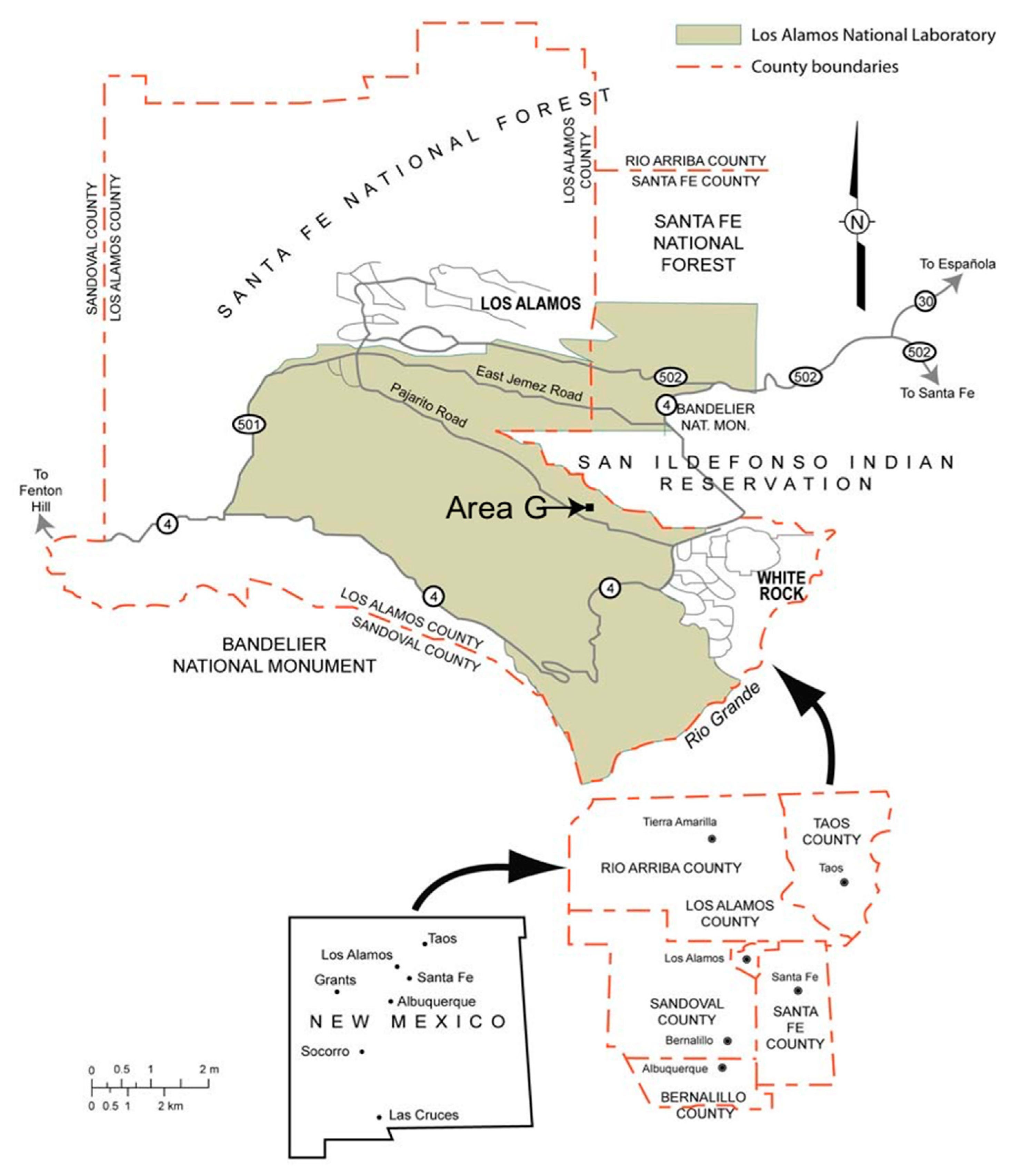
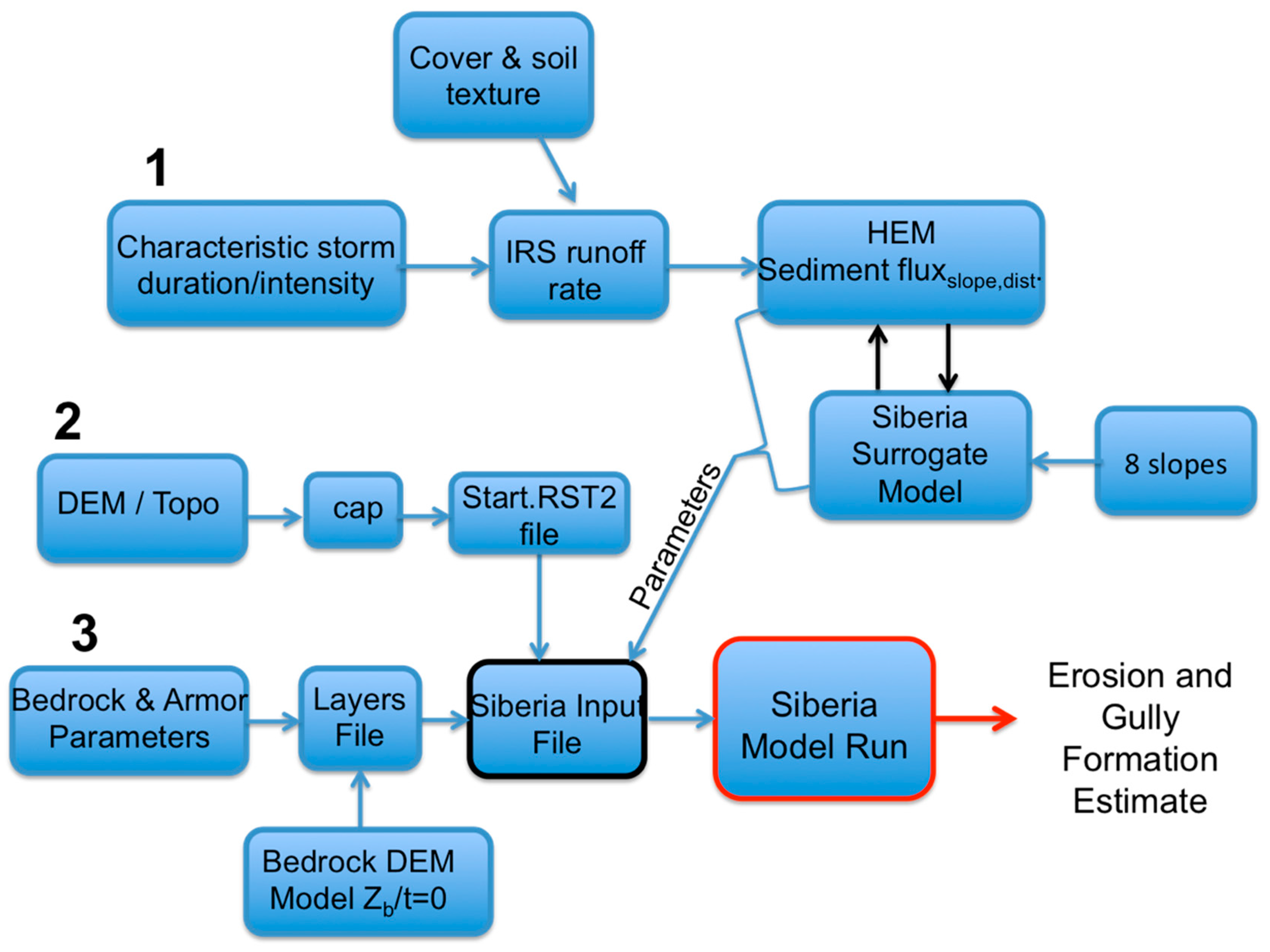

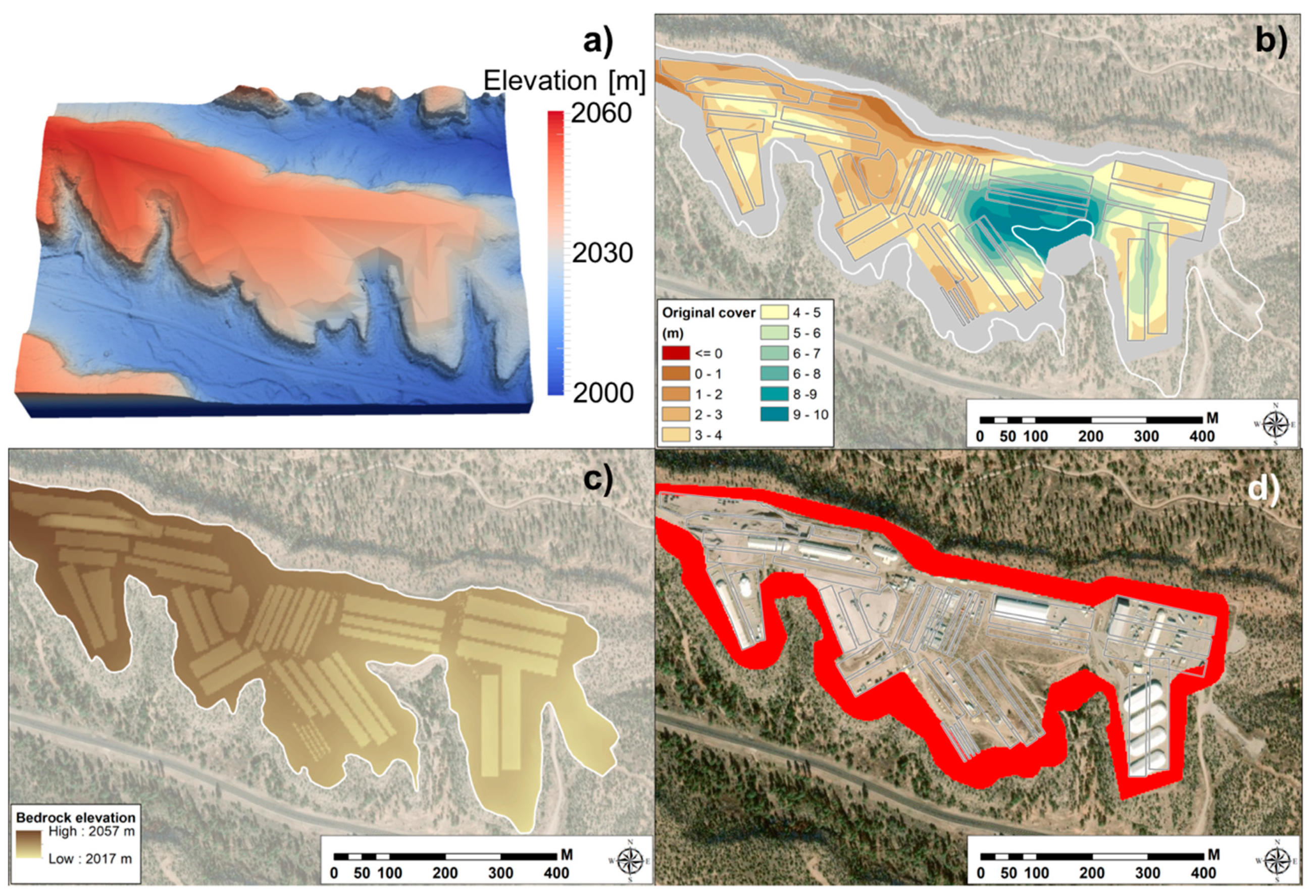
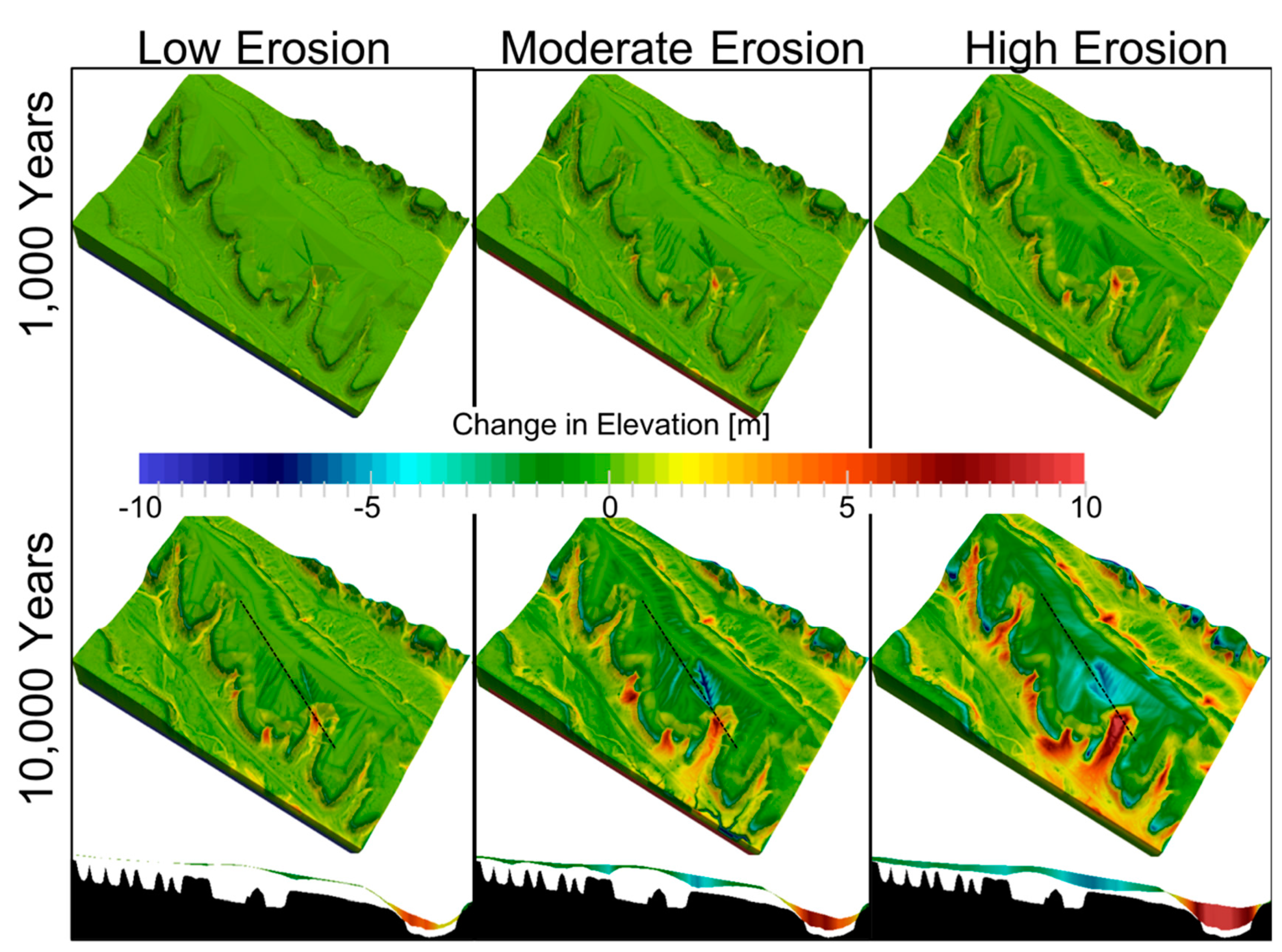
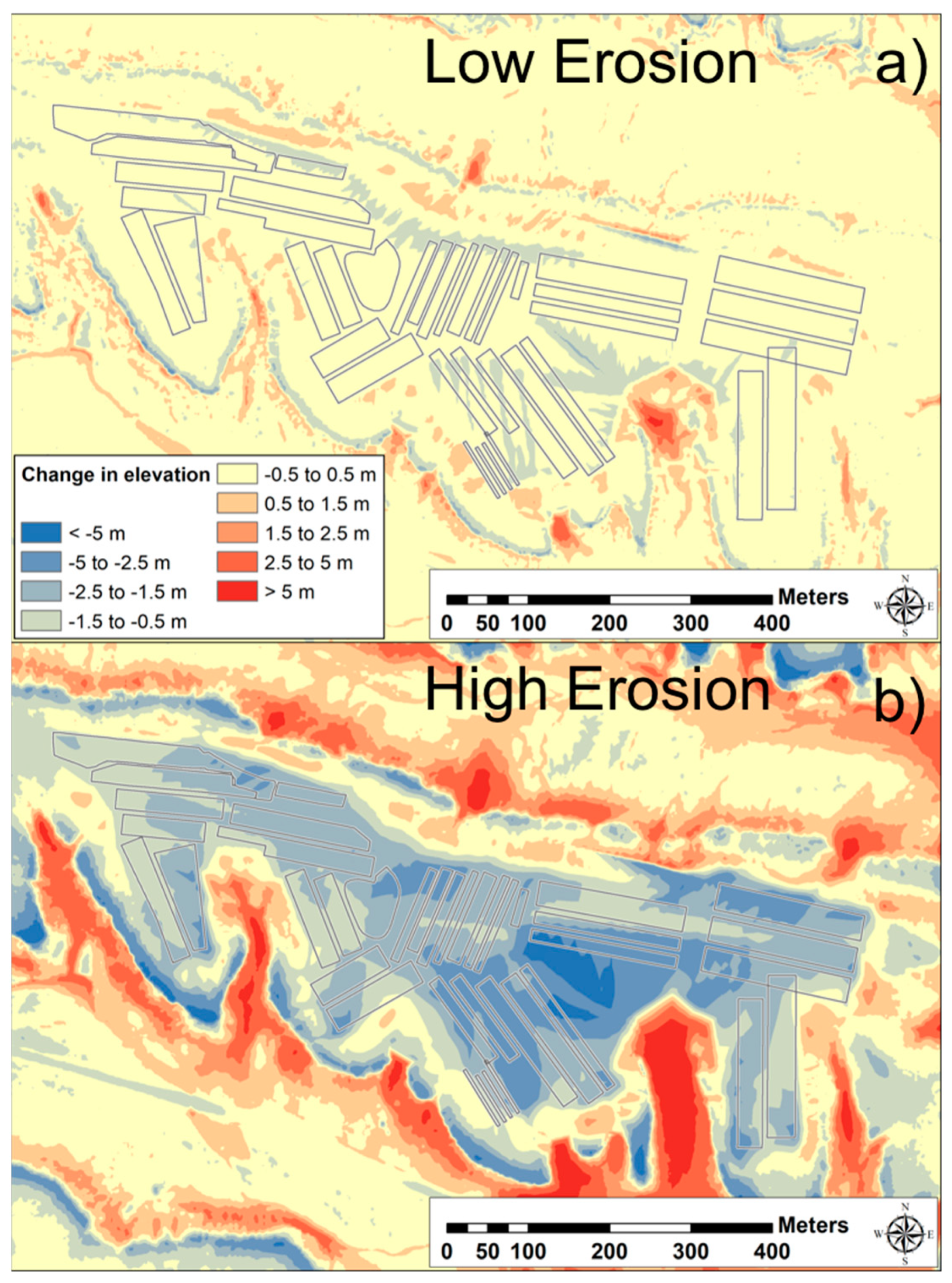
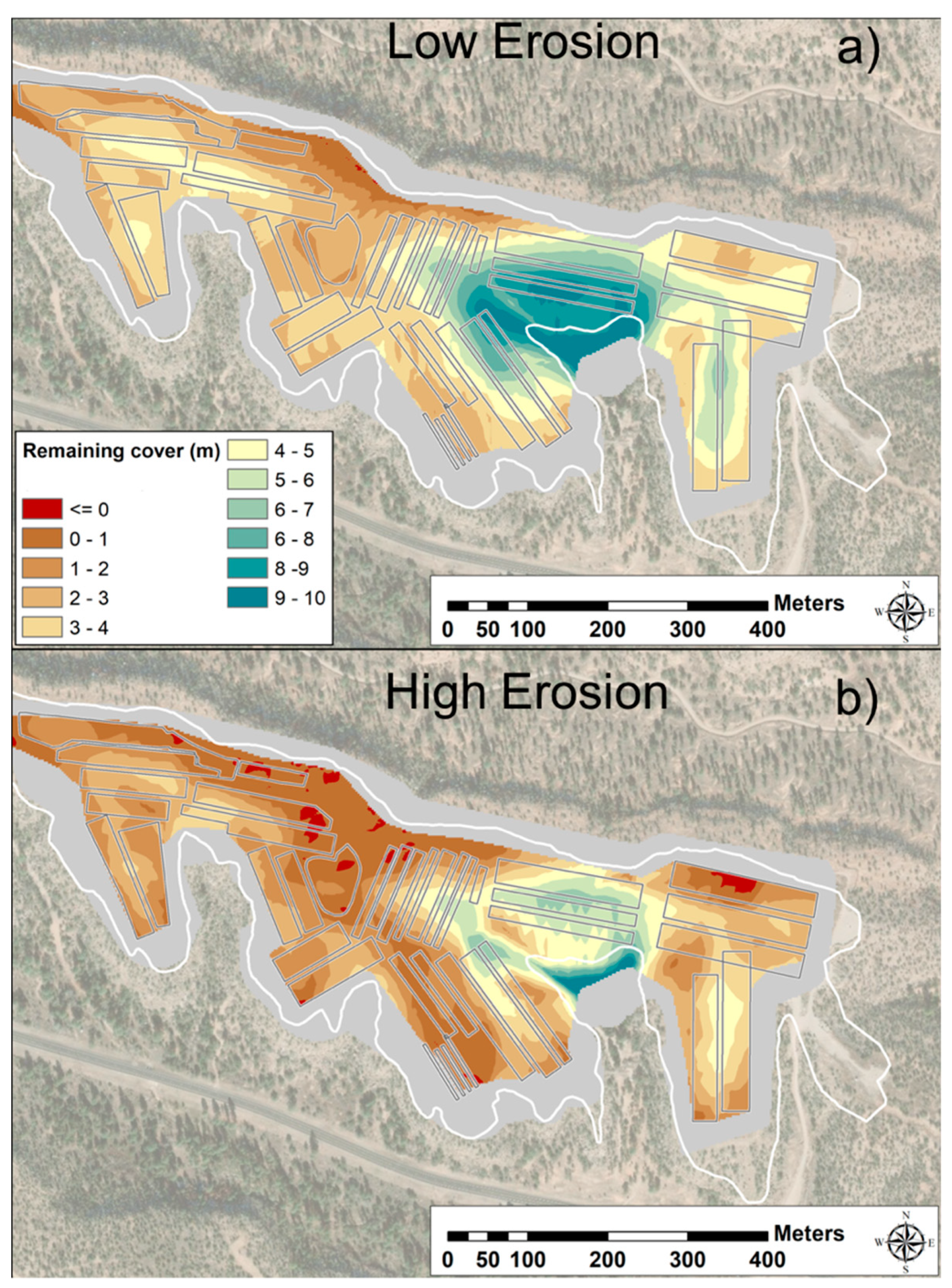

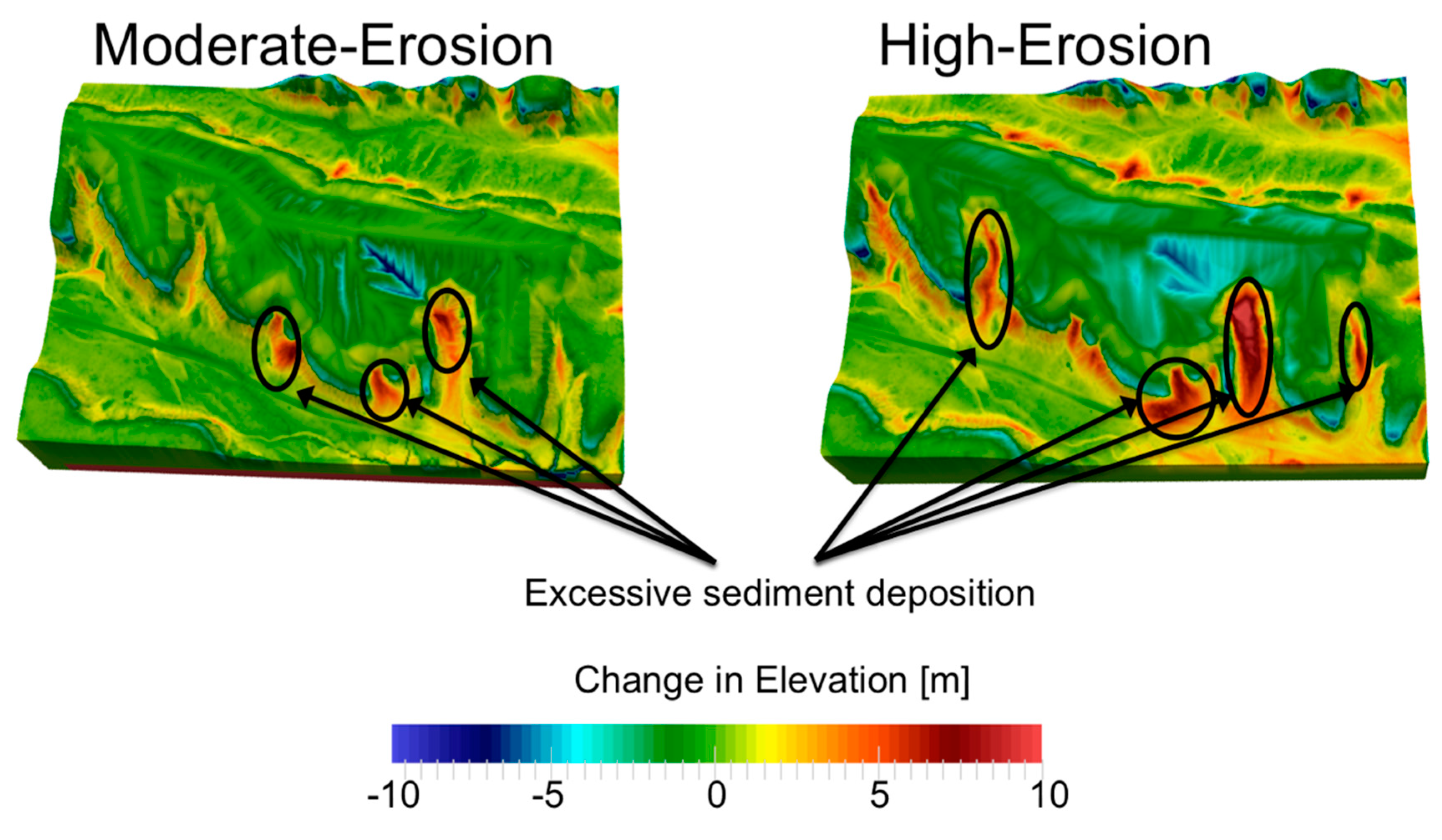
| Profile No. | Profile Name | Total Slope Length (m) | Segments | Average Cover (%) | ||
|---|---|---|---|---|---|---|
| Number | Average Slope (%) a | Canopy | Ground | |||
| 0 | Area G-1 | 78 | 10 | 11.2 | 61 | 23 |
| 1 | Area G-2 | 74 | 5 | 11.9 | 64 | 24 |
| 2 | Area G-3 | 72 | 6 | 13.0 | 63 | 22 |
| 3 | Area G-4 | 91.5 | 10 | 8.2 | 20 | 33 |
| 4 | Area G-5 | 85.5 | 10 | 10.0 | 24 | 46 |
| 5 | Area G-6 | 72.4 | 11 | 10.6 | 26 | 41 |
| 6 | EX-1N | 30.5 | 4 | 5.0 | 8 | 27 |
| 7 | EX-1S | 27 | 4 | 4.1 | 2.9 | 7.9 |
| 8 | EX-2N | 18.3 | 4 | 9.1 | 15 | 44 |
| 9 | EX-3S | 113.5 | 15 | 5.5 | 26 | 40 |
| 10 | EX-4S | 22 | 4 | 6.2 | 12 | 32 |
| 11 | EX-5S | 43.5 | 5 | 6.4 | 6.9 | 17 |
| 12 | EX-6N | 66.5 | 6 | 6.2 | 32 | 61 |
| 13 | EX-7N | 40 | 7 | 10.5 | 27 | 57 |
| 14 | East-1E | 138 | 10 | 12.2 | 29 | 72 |
| 15 | East-2N | 94.5 | 9 | 11.0 | 29 | 69 |
| 16 | East-2S | 74 | 7 | 7.4 | 18 | 54 |
| Profile | Average Cover (%) | Estimated Runoff from 6-h Storm (mm/storm) | |||||
|---|---|---|---|---|---|---|---|
| 2-year Return Period | 5-year Return Period | ||||||
| No | Name | Canopy | Ground | Sandy Loam | Loam | Sandy Loam | Loam |
| 0 | Area G-1 | 61 | 23 | 1.1 | 5 | 4.8 | 10.2 |
| 1 | Area G-2 | 64 | 24 | 0.8 | 4.7 | 4.3 | 9.7 |
| 2 | Area G-3 | 63 | 22 | 1 | 5 | 4.6 | 10 |
| 3 | Area G-4 | 20 | 33 | 3.4 | 7.6 | 8.3 | 14 |
| 4 | Area G-5 | 24 | 46 | 2.2 | 6.4 | 6.8 | 12.3 |
| 5 | Area G-6 | 26 | 41 | 2.4 | 6.6 | 7 | 12.6 |
| 6 | EX-1N | 8 | 27 | 5 | 9.3 | 10.1 | 15.7 |
| 7 | EX-1S | 2.9 | 7.9 | 6.7 | 11.1 | 12.8 | 17.5 |
| 8 | EX-2N | 15 | 44 | 3 | 7.2 | 7.9 | 13.5 |
| 9 | EX-3S | 26 | 40 | 2.4 | 6.7 | 7.1 | 12.7 |
| 10 | EX-4S | 12 | 32 | 4.3 | 8.5 | 9.2 | 14.9 |
| 11 | EX-5S | 6.9 | 17 | 5.8 | 10.1 | 11.4 | 16.5 |
| 12 | EX-6N | 32 | 61 | 0.82 | 4.7 | 4.3 | 9.7 |
| 13 | EX-7N | 27 | 57 | 1.4 | 5.4 | 5.4 | 10.8 |
| 14 | East-1E | 29 | 72 | 0.46 | 4.2 | 3.6 | 9.1 |
| 15 | East-2N | 29 | 69 | 0.58 | 4.4 | 3.8 | 9.3 |
| 16 | East-2S | 18 | 54 | 2.2 | 6.4 | 6.7 | 12.2 |
| Mean | 27 | 39 | 2.6 | 6.7 | 7 | 12.4 | |
| Standard Deviation | 19 | 19 | 1.9 | 2.1 | 2.7 | 2.6 | |
| Model Parameters | Low | Moderate | High |
|---|---|---|---|
| Hillslope Erosion Parameters for IRS and HEM | |||
| Soil Texture | Sandy Loam | Sandy Loam | Loam |
| Canopy Cover/Ground Cover (%) | 70/70 | 30/70 | 30/30 |
| Landscape-Forming Return Interval (year) | 2 | 5 | 5 |
| Excess Runoff (mm) | 2.6 | 7 | 1.2 |
| SIBERIA Model Parameters | |||
| B = Grid Cell Runoff-driven Erosion (-) | 9.4 × 10−6 | 4.2 × 10−5 | 6.8 × 10−4 |
| m = Area Sediment Yield Parameter (-) | 1.6 | 1.6 | 1.3 |
| n = Slope Sediment Yield Parameter (-) | 0.86 | 0.87 | 0.86 |
| Dz = Diffusion Coefficient (kg/m) | 0.003 | 0.0025 | 0.005 |
© 2019 by the authors. Licensee MDPI, Basel, Switzerland. This article is an open access article distributed under the terms and conditions of the Creative Commons Attribution (CC BY) license (http://creativecommons.org/licenses/by/4.0/).
Share and Cite
Atchley, A.L.; Birdsell, K.H.; Crowell, K.; Middleton, R.S.; Stauffer, P.H. Simulating 10,000 Years of Erosion to Assess Nuclear Waste Repository Performance. Geosciences 2019, 9, 120. https://doi.org/10.3390/geosciences9030120
Atchley AL, Birdsell KH, Crowell K, Middleton RS, Stauffer PH. Simulating 10,000 Years of Erosion to Assess Nuclear Waste Repository Performance. Geosciences. 2019; 9(3):120. https://doi.org/10.3390/geosciences9030120
Chicago/Turabian StyleAtchley, Adam L., Kay H. Birdsell, Kelly Crowell, Richard S. Middleton, and Philip H. Stauffer. 2019. "Simulating 10,000 Years of Erosion to Assess Nuclear Waste Repository Performance" Geosciences 9, no. 3: 120. https://doi.org/10.3390/geosciences9030120
APA StyleAtchley, A. L., Birdsell, K. H., Crowell, K., Middleton, R. S., & Stauffer, P. H. (2019). Simulating 10,000 Years of Erosion to Assess Nuclear Waste Repository Performance. Geosciences, 9(3), 120. https://doi.org/10.3390/geosciences9030120





